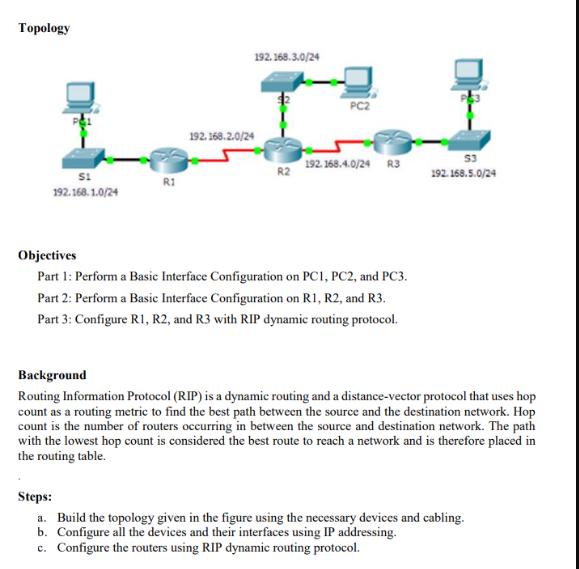Answered step by step
Verified Expert Solution
Question
1 Approved Answer
Topology S1 192.168.1.0/24 R1 192.168.2.0/24 192.168.3.0/24 192.168.4.0/24 R3 R2 53 192.168.5.0/24 Objectives Part 1: Perform a Basic Interface Configuration on PC1, PC2, and PC3.

Topology S1 192.168.1.0/24 R1 192.168.2.0/24 192.168.3.0/24 192.168.4.0/24 R3 R2 53 192.168.5.0/24 Objectives Part 1: Perform a Basic Interface Configuration on PC1, PC2, and PC3. Part 2: Perform a Basic Interface Configuration on R1, R2, and R3. Part 3: Configure R1, R2, and R3 with RIP dynamic routing protocol. Background Routing Information Protocol (RIP) is a dynamic routing and a distance-vector protocol that uses hop count as a routing metric to find the best path between the source and the destination network. Hop count is the number of routers occurring in between the source and destination network. The path with the lowest hop count is considered the best route to reach a network and is therefore placed in the routing table. Steps: a. Build the topology given in the figure using the necessary devices and cabling. b. Configure all the devices and their interfaces using IP addressing. c. Configure the routers using RIP dynamic routing protocol.
Step by Step Solution
There are 3 Steps involved in it
Step: 1

Get Instant Access to Expert-Tailored Solutions
See step-by-step solutions with expert insights and AI powered tools for academic success
Step: 2

Step: 3

Ace Your Homework with AI
Get the answers you need in no time with our AI-driven, step-by-step assistance
Get Started


